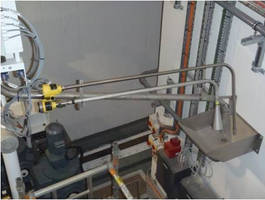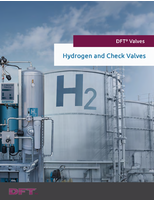Radar and Level Switch on Nuclear Applications
Share:

Radars and switches prove a success on flask filling station at decommissioning site
The Decommissioning Industry
There are a number of Nuclear sites across the UK in the process of being decommissioned, one of which is Dounreay in north of Scotland. The UK nuclear industry is one of the leaders in this field, setting the standards and models for the processing, handling of large and difficult legacy equipment and processes at all levels of contamination, to ensure it is handled, transported and disposed of safely.
Decommissioning generates different types of waste, from conventional industrial wastes to hazardous materials, such as asbestos and radioactive materials. Waste which cannot be safely recycled, is segregated and processed at site ready for transportation and further processing, storage or disposal. About 50 facilities on the site at Dounreay have a history that involved the presence of radioactive materials, and special controls are in place around these to contain radiation. The key to successful decommissioning is careful planning and risk assessment. This is designed to keep to a minimum the exposure of workers to radiological and other hazards to minimise the impact on the environment.
Process challenges
Some items need packaging and shipping in approved transport flasks to storage and reprocessing facilities. The loading of these flasks involves radioactive materials being placed inside and then filled with water, which protects the contents during transport. This loading area is very hazardous and requires remote, robotically operated handling and carefully designed process control systems. The water filling requires precision, the flask needs to be filled right to the top, but stop any over-spilling of the water, as a water clean-up in the filling area is highly undesirable. Notice the water filler ( in figure 1) on the parked position for the rig, should the water level touch the forks and drip off. The measuring range for the radar at the top of the flask is only 0-180mm, and they need secure accurate measurement at this critical stage of the process.
Radars are being used on a variety of applications
An EMPHASIS approved non contact (or through air) VEGAPULS radar is being used for the continuous level measurement. VEGASWING has also been supplied a for the high level switch, a fail safe vibrating fork, also approved for use as it is classified as a 'simple device' (no microprocessors). They have been specially engineered for the application by VEGA engineers working with the customer.
Round the bend
The extensions to the VEGAPULS waveguide and antenna, as well as the VEGASWING tuning fork also has bends to enable them to reach as well as accommodate manoeuvring inside the filling area to carry out their tasks. Both devices were specially designed and fabricated for the application, they are mounted on a pivoting rig, which can be swung over prior to filling for level monitoring and swung back when the flask is lifted in and out.
The radar electronics housing, which incorporates the microwave generator, is mounted well away from the container and hazardous area. The only radar parts inside the area are a stainless steel tube wave guide and a cone antenna (see figure 2) thus avoiding electronics exposure to radaiation. The microwaves, which carry out the measurement, are guided along the tube then transmitted and received back by the cone antenna at the end. The technology of VEGA radars has proven extremely capable and adaptable, with 'bespoke' waveguides up to and over 8m. This configuration is employed in many industries; waste, marine, chemical and molten metal processing, where remote mounting of the radar is desirable for various reasons. VEGASWING offers a level switch point which is mm repeatable. It uses tuning fork based level switch, this consists of a small piezo-drive screwed to the back of the forks to produce the vibration needed to detect liquid. A cable runs up inside the tube to the electronics module in the housing, where the vibrating element is monitored and the switch output connected. The VEGASWING also had a bent tube design engineered to work with the filling arm and mount alongside the radar the tuning forks are also mounted in a protection cage in case of accidental damage during manoeuvring of the filling rig and flask.
Technology explanation
VEGAPULS Radar uses microwave pulses which transmit to, and reflect back from, the product surface. In this instance they travel initially inside a tube several metres long, before being transmitted through air, many non-contact systems would pick up too much noise and signal interference from the 'tube' to offer the reliability and accuracy needed. As VEGA use pulsed radar with advanced ECHOFOX signal processing, all echoes are discrete in time and the software can be easily set-up to only measure, in this case, over a specific 180mm measuring range beyond the end of the cone antenna. Radars can measure over many metres beyond the antenna, still with very good accuracy and repeatability.
The VEGAPULS radar level transmitter, originally assessed by Exida for SIL applications, was also independently assessed by Sellafield Ltd, as part of the EMPHASIS project to satisfy the NII. It is now deemed acceptable for this sensor to be deployed in suitable SIL1 applications for the UK Nuclear industry. More information, search on your browser for articles on 'VEGA EMPHASIS approved radars'.
VEGASWING is a universal liquid level switch. As it has no microprocessors, this allows it to be classed as a 'simple device' thus making it suitable for many applications by the Nuclear industry. By using an 'active element', it has an inherently fail-safe design, where power loss, damage, build-up or corrosion, will cause the switch to fail-safe. When it touches liquid, the vibrating tuning fork element is damped and it gives a switch output. This micro dynamic, 'solid state' mechanical technology enables it to detect almost any type of liquid, without needing floats or linkages. It doesn't require the 'tuning with product level' for set up, associated with solid state electrical level probes. It conforms to IEC 61508/11: SIL 2, there is also a remote self-test option for checking operational readiness.
Looking to the future
VEGAPULS EMPHASIS approved radars look set to play a big part in the nuclear industry, both on decommissioning and any future new builds. The flexibility of non-contact devices and designs have helped with some key applications, as well as meeting the security of design, cost and engineering criteria for more 'routine' applications, such as vessel and sump level control. The range of specifications and prices mean it can fit both technical and commercial needs for a very wide range of uses.
VEGASWING also has great potential too, providing reliable, fail safe level detection on many liquids with its capability for 'universal' level detection, and classification in the industry as a 'simple device'. The remote test facility also delivers additional security for the user on applications where the switches' operational readiness can be tested periodically in 'low demand' applications, to ensure a process is protected properly.
Doug Anderson
Marketing Manager
E-Mail: doug.anderson@vega.com
VEGA Controls Ltd
Web: www.vegacontrols.co.uk
Tel +44 1444 870055
Fax +44 1444 870080
VEGA Controls Ltd
Kendal House, Victoria Way
Burgess Hill, West Sussex
RH15 9NF
Tel: 01444 870055
Fax: 01444 870080



